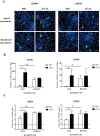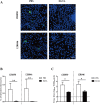Porcine rotavirus mainly infects primary porcine enterocytes at the basolateral surface
- PMID: 31856906
- PMCID: PMC6924034
- DOI: 10.1186/s13567-019-0728-x
Porcine rotavirus mainly infects primary porcine enterocytes at the basolateral surface
Abstract
Intestinal epithelium functions as a barrier to protect multicellular organisms from the outside world. It consists of epithelial cells closely connected by intercellular junctions, selective gates which control paracellular diffusion of solutes, ions and macromolecules across the epithelium and keep out pathogens. Rotavirus is one of the major enteric viruses causing severe diarrhea in humans and animals. It specifically infects the enterocytes on villi of small intestines. The polarity of rotavirus replication in their target enterocytes and the role of intestinal epithelial integrity were examined in the present study. Treatment with EGTA, a drug that chelates calcium and disrupts the intercellular junctions, (i) significantly enhanced the infection of rotavirus in primary enterocytes, (ii) increased the binding of rotavirus to enterocytes, but (iii) considerably blocked internalization of rotavirus. After internalization, rotavirus was resistant to EGTA treatment. To investigate the polarity of rotavirus infection, the primary enterocytes were cultured in a transwell system and infected with rotavirus at either the apical or the basolateral surface. Rotavirus preferentially infected enterocytes at the basolateral surface. Restriction of infection through apical inoculation was overcome by EGTA treatment. Overall, our findings demonstrate that integrity of the intestinal epithelium is crucial in the host's innate defense against rotavirus infection. In addition, the intercellular receptor is located basolaterally and disruption of intercellular junctions facilitates the binding of rotavirus to their receptor at the basolateral surface.
Conflict of interest statement
The authors declare that they have no competing interests.
Figures







Similar articles
-
Infection of porcine enteroids and 2D differentiated intestinal epithelial cells with rotavirus A to study cell tropism and polarized immune response.Emerg Microbes Infect. 2023 Dec;12(2):2239937. doi: 10.1080/22221751.2023.2239937. Emerg Microbes Infect. 2023. PMID: 37483148 Free PMC article.
-
Polarized rotavirus entry and release from differentiated small intestinal cells.Virology. 2016 Dec;499:65-71. doi: 10.1016/j.virol.2016.09.010. Epub 2016 Sep 16. Virology. 2016. PMID: 27639572
-
Establishment of porcine enterocyte/myofibroblast co-cultures for the growth of porcine rota- and coronaviruses.Sci Rep. 2018 Oct 12;8(1):15195. doi: 10.1038/s41598-018-33305-1. Sci Rep. 2018. PMID: 30315177 Free PMC article.
-
The actin cytoskeleton as a barrier to virus infection of polarized epithelial cells.Viruses. 2011 Dec;3(12):2462-77. doi: 10.3390/v3122462. Epub 2011 Dec 21. Viruses. 2011. PMID: 22355449 Free PMC article. Review.
-
Rotavirus Interactions With Host Intestinal Epithelial Cells.Front Immunol. 2021 Dec 22;12:793841. doi: 10.3389/fimmu.2021.793841. eCollection 2021. Front Immunol. 2021. PMID: 35003114 Free PMC article. Review.
Cited by
-
Drosophila melanogaster as a model system for studying the effects of porcine rotavirus on intestinal immunity.Front Cell Infect Microbiol. 2025 Jul 28;15:1621846. doi: 10.3389/fcimb.2025.1621846. eCollection 2025. Front Cell Infect Microbiol. 2025. PMID: 40792103 Free PMC article.
-
Gut Susceptibility to Viral Invasion: Contributing Roles of Diet, Microbiota and Enteric Nervous System to Mucosal Barrier Preservation.Int J Mol Sci. 2021 Apr 29;22(9):4734. doi: 10.3390/ijms22094734. Int J Mol Sci. 2021. PMID: 33946994 Free PMC article. Review.
-
Frequent Occurrence of Simultaneous Infection with Multiple Rotaviruses in Swiss Pigs.Viruses. 2022 May 23;14(5):1117. doi: 10.3390/v14051117. Viruses. 2022. PMID: 35632858 Free PMC article.
-
Loss of mucin 2 and MHC II molecules causes rare resistance to murine RV infection.J Virol. 2025 Feb 25;99(2):e0150724. doi: 10.1128/jvi.01507-24. Epub 2024 Dec 27. J Virol. 2025. PMID: 39727412 Free PMC article.
-
Infection of porcine enteroids and 2D differentiated intestinal epithelial cells with rotavirus A to study cell tropism and polarized immune response.Emerg Microbes Infect. 2023 Dec;12(2):2239937. doi: 10.1080/22221751.2023.2239937. Emerg Microbes Infect. 2023. PMID: 37483148 Free PMC article.
References
MeSH terms
Substances
Grants and funding
LinkOut - more resources
Full Text Sources

